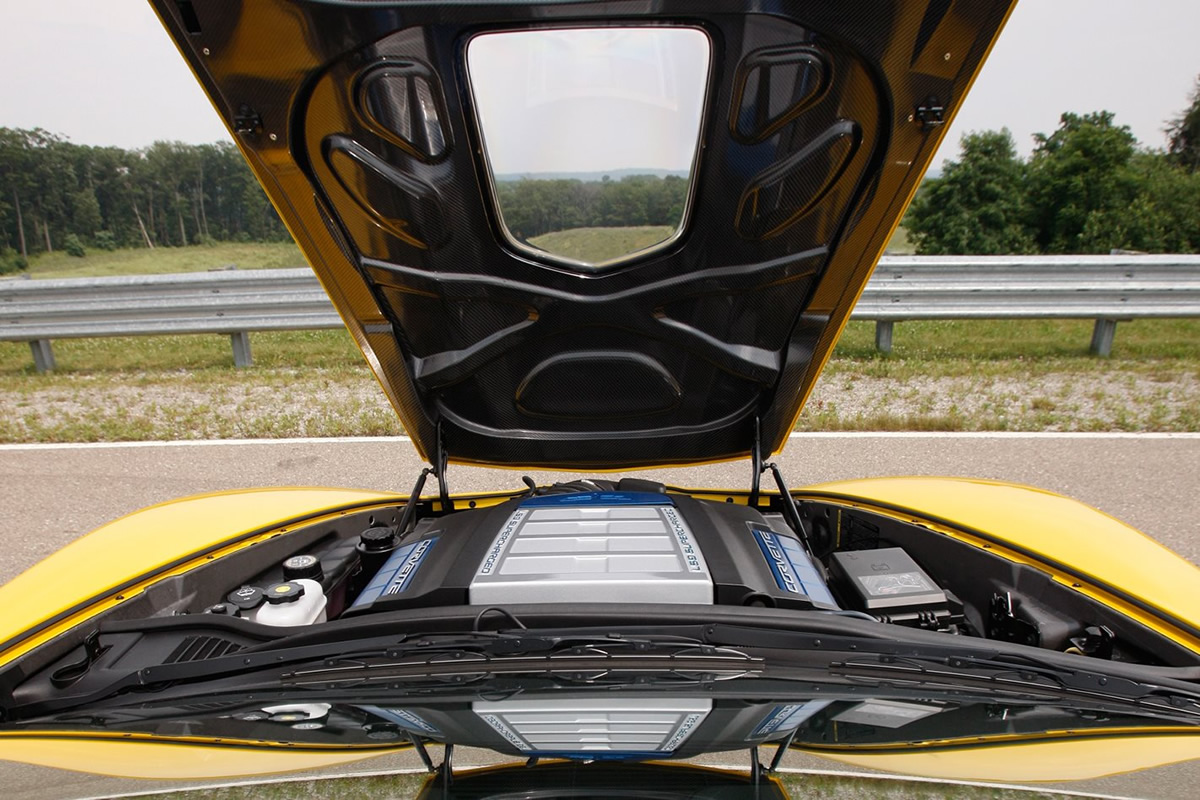Tech Article: The 2009 Corvette ZR1's Carbon Hood Creates Shock and Awe
Corvette's carbon hood creates shock and awe
North America's first mass-produced, all-CFRP hood raises the bar for production sports cars.
Case Study From: Composites Technology August 2009, Peggy Malnati
Posted on: 7/20/2009
How do you refresh an already iconic sports car? Such was the challenge faced by Chevrolet Corvette and Cadillac XLR vehicle chief engineer Tadge Juechter and his team as they began working on the latest-generation Corvette ZR1 sportscar. Throughout its half-century history, the Corvette always has had a composite body, and the new ZR1 would be no exception. Charged with creating the latest iteration, Corvette engineers sought technologies that would make it the fastest, lightest, best-handling and most comfortable 'Vette ever, using the latest engine and chassis upgrades and the lightest, strongest advanced materials available, with a strong visual signature capable of producing “shock and awe.” To complete that ambitious quest, the Corvette team exploited its growing confidence in carbon composites to fashion an innovative hood that formed the crowning piece of that successful transformation.
Growing into CFRP
The 50th Anniversary '04MY Corvette Z06 Commemorative Edition, marked General Motors' (GM, Detroit, Mich.) first use of Class A painted CFRP on a body panel. Thirty-six percent of the Z06 models were Commemorative Editions, featuring a standard-equipment CFRP hood. Only the hood's outer shell, however, was converted to carbon/epoxy. The inner remained sheet molding compound, (SMC). But the change shaved 11 lb/4.9 kg from the car's overall weight. Although paint hid the carbon reinforcement from view, a “peek-a-boo” appearance decal on the hood's inner perimeter gave it a high-tech carbon-weave look.
Buoyed by that experience, the Corvette team returned to the drawing board to begin the Z06 refresh. They added CFRP fenders, floors and wheel housings (see “Corvette converts floor panels, wheelhousings from glass to carbon,” under "Editor's Picks," at right). Although its hood reverted to standard SMC, this expanded use of advanced composites reduced curb weight by 19 lb/8.6 kg.
As planning began for the fall 2008 launch of the ZR1, the team opted for greater carbon fiber intensity to meet design goals. The ZR1 team worked closely with Plasan Carbon Composites (Bennington, Vt.), the supplier of CFRP fenders for the Z06, based on Plasan's already proven ability to produce a large number of Class A carbon fiber composite body panels — a skill set uncommon in an industry dominated by steel.
Structure and aesthetics
Click on the images below for a larger view:
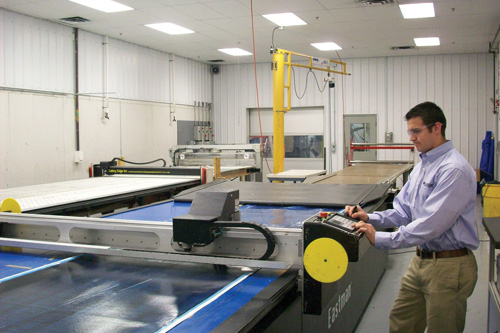 |
 |
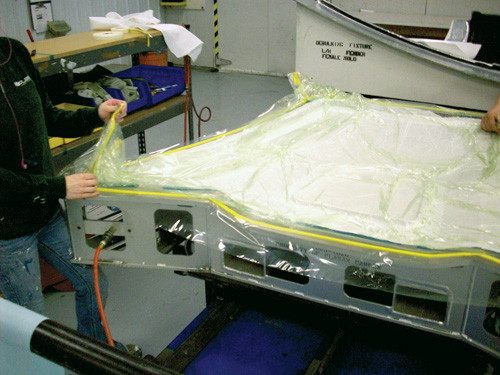 |
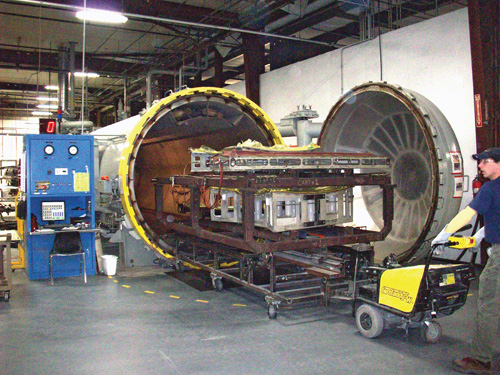 |
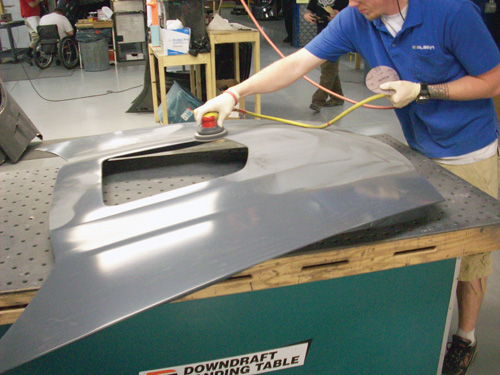 |
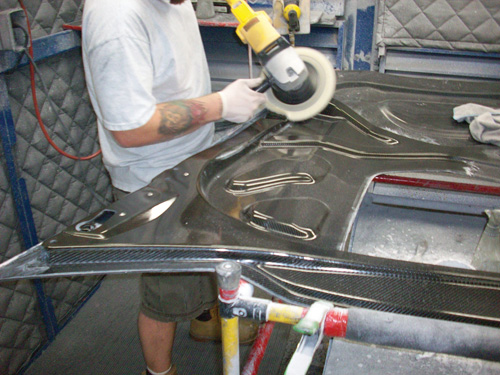 |
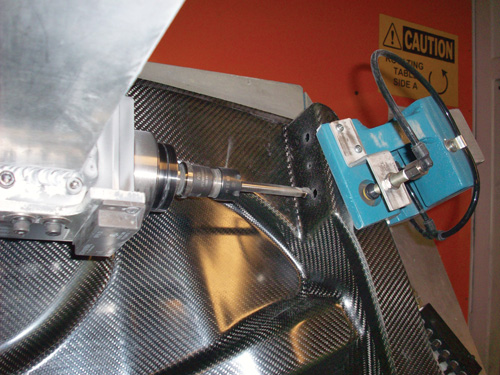 |
 |
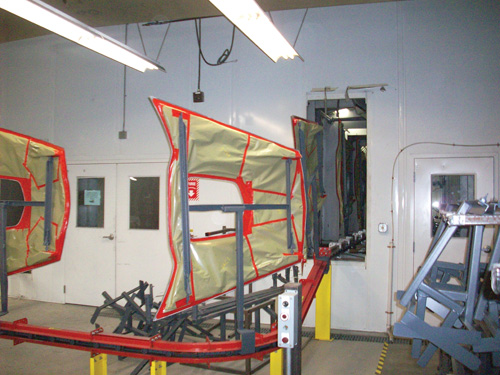 |
Because the ZR1's engine would sport a supercharger, the team knew, going in, that the Z06 hood would require retooling to accommodate the greater engine dimensions. To achieve as close to a 50/50 front-to-back weight distribution as possible, and to offset the extra engine weight on the front axle, the new hood also had to be lighter. “The design we went with was a natural confluence of our desire to take weight out, our recognition that we had to retool the hood anyway, and the need to make the hood higher in the middle to accommodate the supercharger,” Juechter recalls, but adds that the team was adamant about the hood's aesthetic: “We didn't want it to look too tall, as this is a very high-performance car and we didn't want the driver to feel claustrophobic inside or have visibility impaired.” This eliminated options popular on 1960s-era muscle cars — a mid-hood bulge or a hole in the hood through which the supercharger would project.
That said, there was no desire to hide the supercharger, either. To take full visual advantage, the team borrowed a concept current in much pricier vehicles. “Since many rear-engine supercars showcase their engines, we took that idea and used it to visually differentiate the ZR1 by creating a window on this front-engine car. The effect is a more open, forward view and a huge styling enabler.”
Given the ZR1 team's desire to keep the hood as thin and as low as possible, an immediate design challenge was the reduction of the normally sizeable air gap between the top of the engine and the hood, which helps cool the engine. The space also allows for engine movement on its rubber mounts while running. Engineers must figure a clearance margin to accommodate movement and then design it into their build tolerances.
It was clear that vehicle's supercharger would fit up very close to the underside of the hood, necessitating the use of materials with high temperature and chemical stability as well as stiffness and strength. Another challenge was the loss of the inner hood liner/blanket, which provides high-frequency noise abatement and hides the normally unsightly underhood surface. Fortunately, the new engine turned out to be very quiet (GM claims the ZR1 is the quietest supercharged car on the road), so noise abatement became a relative nonissue. Such was not the case with underhood appearance. Because Corvettes spend a lot of time at car shows with their hoods open, the team wanted a pristine hood underside.
Given all these considerations, the hood was designed as a two-piece, hollow, bonded assembly similar to the CFRP/SMC hood on the Z06 model, but this time exclusively in carbon fiber/epoxy. The painted outer panel features six layers of alternating 0/90 unidirectional carbon fiber prepreg, supplied by Engineered Textile Solutions (ETS, Darien, Conn.). To address the underhood aesthetic, the inner panel was faced with a layer of high-tensile-strength carbon weave over four layers of 0/90 unidirectional prepreg. Advanced Composites Group Ltd. (ACG, Heanor, Derbyshire, U.K.) supplied woven fabrics pre-impregnated with a special low-VOC, fast-cure epoxy resin developed by ACG for this application. All the carbon fiber for the prepregs was supplied by Zoltek Inc. (St Louis, Mo.).
As one might expect, quality standards for this part are extremely high — no twisted fiber bundles or loose yarns allowed. To maintain the high aesthetics, an exposed-weave stabilizer was developed by ACG with Plasan to ensure uniform carbon fiber weave during molding and display. Immediately after the fabric is woven, the stabilizer is applied, like spray starch on shirt fabric, to hold the fibers in position.
While the hood's attachment points did not change significantly from the Z06 design, it was necessary, given carbon's electro-conductivity, to change fasteners to stainless steel to increase resistance to galvanic corrosion. As an extra measure of safety, the hood also features internal reinforcements and catch brackets to keep the trailing edge of the hood from traveling backwards and penetrating the windshield during a frontal crash — no small concern when the driving speeds of this racetrack-capable sportscar can be in excess of 200 mph/322 kph.
For the hood's clear window, the team selected an injection-molded polycarbonate (PC) panel, 0.18 inch/4.5 mm thick, and hardcoated on both sides to enhance scratch and chemical resistance. It was made by LexaMar Corp., a division of Magna International (Aurora, Ontario, Canada).
Putting it all together
Speed of execution was a concern when developing the manufacturing process, because production volumes for the ZR1 fall between 1,500 and 2,000 units annually, making this the first “mass-produced” all-CFRP hood.
Despite the difficulty of the molding process, each part can be molded in a single tooling operation (vs. multiple stampings required in metals) owing to the inherent strength and bending stiffness of the CFRP materials. During development, Plasan investigated a variety of different layup, kit and bagging methods to find a process combination that yielded the best appearance and performance within the shortest processing time.
Hood production begins with kit cutting. Rolls of carbon prepreg are loaded onto a cutting table supplied by Gerber Technology (Tolland, Conn.) and Eastman Machine (Buffalo, N.Y.) and cut into an individual kit of pieces needed to produce a complete hood (separate sets for outer and inner). Because Plasan is producing a number of CFRP parts for the ZR1, managing and organizing kits is a major aspect of production.
Kit components are hand-layed into single-sided, female steel tools produced by Models & Tools (Shelby Township, Mich.). Notwithstanding their complexity and high tolerance control, the tools (one each for top and bottom panels) cost $1 million (USD) less than tools for a comparable SMC hood. Highly trained layup technicians visually inspect prepregs and use special techniques to position plies precisely on the first try to minimize pulling or stretching of plies, which could distort the appearance, explains Lars Severance, Plasan's manufacturing engineer.
When layup is complete, the parts are vacuum bagged and moved to one of Plasan's four production-size autoclaves where, thanks to ACG's fast-cure epoxy, they cure in about 10 minutes. The total production cycle time for a hood, from layup through cure, is about 60 minutes.
Because of their complex plan-view sweeps, demolded parts are edge-machined on an automated, high-speed, 5-axis robotic router from KMT Robotic Solutions (Auburn Hills, Mich.), which is capable of cutting very tight radii and negotiating complex slope changes at high spindle loads.
Next, the hood inner and outer panels are prepped for adhesive application and placed in a bonding cell. Here, they are robotically bonded around the perimeter edges using a two-part structural urethane specially formulated by Ashland Inc. (Dublin, Ohio) to cure quickly, survive paint-bake oven temperatures and exhibit the high strength necessary to prevent debonding of inner and outer panels under the stresses of high-speed operating conditions.
Each hood is 100-percent hand finished. Trained technicians sand the outers and hand-polish the inners to a diamond-like finish, giving it the look of a clearcoat without the expense of the extra step. Then, the inner panel is masked, the assembly is passed through Plasan's primer booth and, when cured, the primed hoods are shipped to Creative Liquid Coatings (Ft. Wayne, Ind.) to be painted. Just before final quality-control inspection, the polycarbonate window is joined to the hood assembly. To accommodate the coefficient of thermal expansion (CTE) mismatch between the CFRP and the PC, technicians use a special compliant shear/ductile urethane adhesive, also provided by Ashland. In what has been described as the only real challenge encountered in the window's development, early installs had a few tiny leaks as the team learned to use the adhesive and equipment, but the problem was soon eliminated.
Completed units are shipped to GM's Bowling Green, Ky., assembly plant for installation on ZR1s.
Shock and awe
Surprisingly, the hood program moved from surface drawings to production parts in less than 12 months, an astonishing achievement given the number of inventions necessary to make it all work. Just as impressive, the new 52-inch by 60-inch (1,320-mm by 1,524-mm) hood weighs only 12 lb/5.4 kg. To put this in perspective, a comparable-size hood would weigh 70 to 80 percent more in steel, 35 to 40 percent more in aluminum or magnesium alloy and 40 to 50 percent more in SMC. And despite the fact that each panel has a nominal wall thickness of only 0.05 inch/1.3 mm, the hood assembly met all U.S. Federal Motor Vehicle Safety Standard (FMVSS) requirements for frontal crashes and GM's durability, vibration and environmental performance requirements — an outcome all the more impressive because the ZR1 is engineered for high-speed track racing and, as Juechter points out, Corvettes are engineered for a 20-year life rather than the industry-standard of 10 years. “Most of the Corvettes we've ever made are still on the road,” he contends.
The finished Corvette ZR1 production hood with its unique clear window offers the hoped-for visual impact from all angles on a car that sets new industry standards. At an MSRP of $105,000 (USD), the ZR1 delivers the performance and the jewel-like look of a hand-finished, half-million-dollar supercar.
